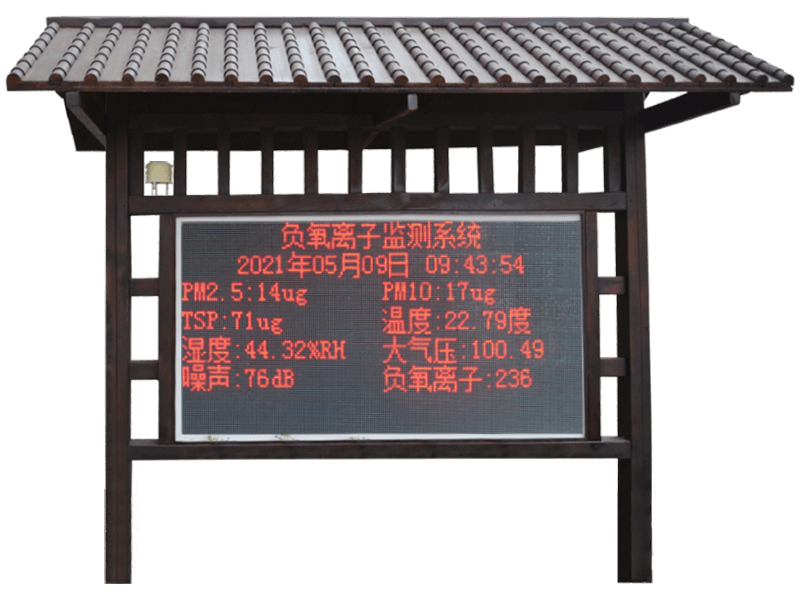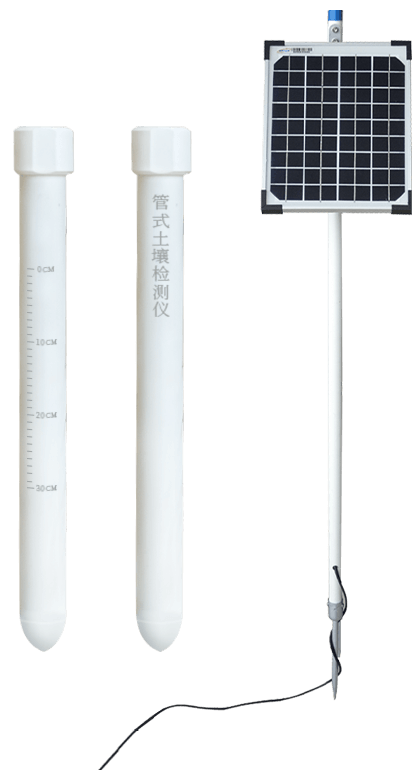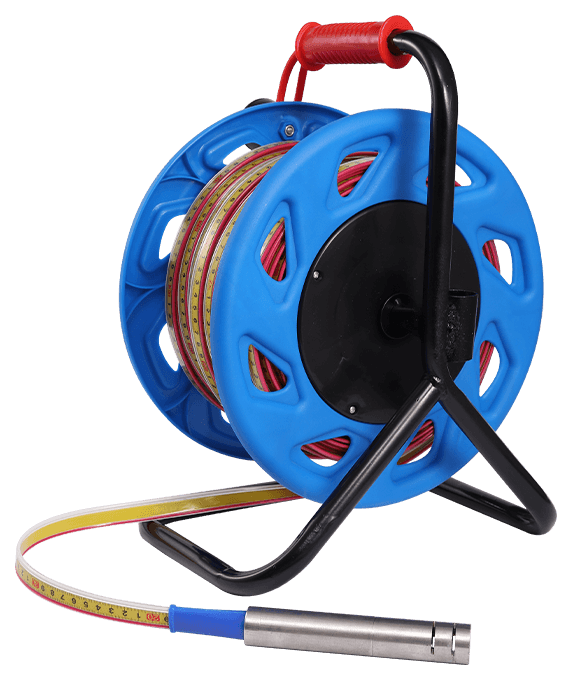
Negative Oxygen Ion Monitoring System
- Product Number:LD-FY06
- Product Difference:Wood Pavilion Edition, monitors negative oxygen ions, PM2.5, PM10, temperature, humidity, atmospheric pressure, oxygen content, noise, wind speed, wind direction, etc
Product Introduction
The negative oxygen ion monitoring system tracks parameters including negative oxygen ions, PM2.5, PM10, temperature, humidity, atmospheric pressure, oxygen content, noise, wind speed, and wind direction. This system provides real-time environmental and meteorological monitoring and reporting for sectors including forestry, scenic areas, parks, environmental protection, meteorology, and agriculture. It is primarily designed for centralized monitoring and management of air quality environments in scenic areas and parks, functioning as an automated monitoring system capable of unattended, 24/7 continuous real-time monitoring and recording.
The system monitors and records air quality across large areas, transmitting data in real-time to a PC. Utilizing system monitoring software, it stores and analyzes data, outputs historical data and trend graphs for printing, and supports on-site audible/visual alarms, phone alerts, SMS notifications, and web client alerts.
The negative oxygen ion monitoring system simultaneously tracks multiple environmental parameters, with expandable or reducible modules based on user requirements. It transmits monitored environmental data 24/7. Its unique modular design allows interchangeable sensors. Standard professional mounting brackets enable installation on walls or columns, ensuring highly convenient operational maintenance.
Scenic Area Tourist Attraction Negative Ion Online Monitoring System LED Display Screen, Negative Ion Online Monitoring System, Meteorological Bureau Atmospheric Negative Oxygen Ion Automatic Monitoring System, Air Negative Ion Environmental Monitoring System.
Product Features
This system is a fully unmanned solution capable of continuously collecting and recording air quality changes at monitoring points in real-time, 24 hours a day. It displays and stores monitoring information in multiple formats including digital data, graphs, and images. The number of monitoring points can be expanded to over a thousand.
Upper and lower alarm thresholds can be set for each monitoring point. When abnormal data occurs at a monitored point, the system automatically triggers an alarm signal. Alarm methods include: on-site multimedia audio, audible/visual alarms, network client alerts, and mobile text message notifications. Alarm information is uploaded for both local and remote monitoring, enabling the system to notify different on-duty personnel at different times.
The system supports various data analysis and processing software for creating bar charts, pie charts, curve fitting, and more. Data can be exported in TEXT format or imported into Office software like Excel for further processing.
The air quality monitoring software employs a standard Windows graphical interface with full Chinese support. It displays and records real-time air quality values and curve changes at each monitoring point, while also compiling historical data, maximum/minimum values, averages, and cumulative statistics for monitored quality parameters.
Output control functions can be expanded as needed. The air quality monitoring system integrates seamlessly with park misting systems to enable shared data display. The monitoring system can operate independently or integrate with the misting system for linked, intelligent control.
The control software is developed using software engineering management principles, ensuring high openness and scalability. Adopting a system design philosophy that software-enables hardware functions, along with modular hardware and networked communication, allows for software upgrades and hardware expansion as needed.
All systems feature reliable grounding to prevent electrostatic discharge.
Continuously tracks and records environmental changes at each monitoring point.
Collects real-time air quality data with millisecond-level sampling intervals for rapid response.
Users can view and analyze data through management software, and archive or print charts and reports.
The system employs single-wire and multi-wire bus cabling, significantly reducing wiring complexity, material usage, and project costs. Digital signal transmission eliminates transmission errors or signal loss.
Powerful data processing and communication capabilities utilize computer network technology. Any computer within the local area network can access the monitoring computer to view real-time air quality changes at monitoring points, enabling remote monitoring.
The system design incorporates reserved interfaces, allowing hardware devices to be added or removed at any time with minimal system modifications, enabling rapid implementation.
Digital signal output with RS485 communication interface. Multiple communication methods can be expanded as needed, such as Wi-Fi or GPRS transmission.
LCD display provides real-time air quality information at a glance.
The entire unit features lightning protection design, minimizing damage in areas prone to thunderstorms.
Product parameters
| LED Display Screen | Dimensions: 2×1 m, including mounting bracket | |
| Air Negative Oxygen Ions | Measurement Method | Cylindrical Electrode Aspiration Method |
| Measurement Range | 0–100,000 ions/cm³, Resolution: 1 ion/cm³ | |
| Measurement Error | ±10% of reading | |
| Ion Mobility | ≤±20% | |
| Measurement Resolution | 1 ion/cm³ | |
| Sampling Frequency | 10 times/s | |
| Ion Mobility | 0.4–1.0 (cm²/V•sec) | |
| Power Supply | Built-in 3.7V 2000mAh Lithium Battery | |
| Operating Environment | Temperature: -40°C to 60°C, Humidity 10–70% RH | |
| Average Power Consumption | ≤1.4W | |
| Dimensions & Weight | 120×80×38 (mm), 400g | |
| Protection Rating | IP41 | |
| Oxygen Content | Oxygen Content Measurement Range | 0~25% Vol |
| Oxygen Content Measurement Accuracy | ±3% uol | |
| Ambient Temperature & Humidity | Temperature Measurement Range | -40~60℃ |
| Temperature Accuracy | ±0.3℃ | |
| Humidity Measurement Range | 0~100% RH | |
| Humidity Accuracy | ±3% | |
| Wind Speed & Direction | Wind Speed Measurement Range | 0~60m/s |
| Wind Speed Accuracy | ±(0.3+0.03V)m/s | |
| Wind Direction Measurement Range | 0~360° | |
| Wind Direction Accuracy | ±3° | |
| Atmospheric Pressure | Atmospheric Pressure Measurement Range | 10~1100 hPa |
| Atmospheric Pressure Accuracy | ±0.3 hPa | |
| Particulate Matter Monitoring (PM2.5/PM10/TSP) | Measurement Range | 25~500 μg/m³ |
| Particulate Matter Resolution | 0.01 mg/m³ | |
| Particulate Matter Accuracy | ±10% relative to standard particles | |
| Noise | Range | 30~130dB |
| Frequency | 31.5Hz~8kHz | |
| Accuracy | ±1.5dB | |
| Data Acquisition Unit | Ambient Temperature | -40 — 75 ℃ |
| Sampling Frequency | 0.5s/cycle | |
| Power Supply | 220VAC | |
| Display Format | LCD Display | |
| Power Consumption | Total Power Consumption ≤ 2W | |
| Data Storage Capacity | 4M | |
| Functions | Intelligent Acquisition, Storage, Parameter Setting Functions | |
| Storage Capacity | 100,000 data entries | |
| Equipped with Standard | RS485 port for connection to PC or laptop; supports standard MODBUS protocol for secondary programming via host computer software | |
| Communication Methods | Supports GPRS/GSM/WiFi/SMS communication. (Optional based on customer requirements) | |
| External Interface Expansion Capability | Supports on-site and remote parameter configuration or programming operations for reading device data. Features rational circuit design and strong resistance to external interference. | |
| Data Acquisition Software | Supports computer data collection, real-time clock, scheduled storage, parameter configuration, negative oxygen ion parameter monitoring, and power failure protection for historical meteorological data | |
| Anti-corrosion Wooden Landscape Pavilion | Can be used for LED display bracket upgrades | |

 +86 19353291814
+86 19353291814
 +86 19353291814
+86 19353291814

